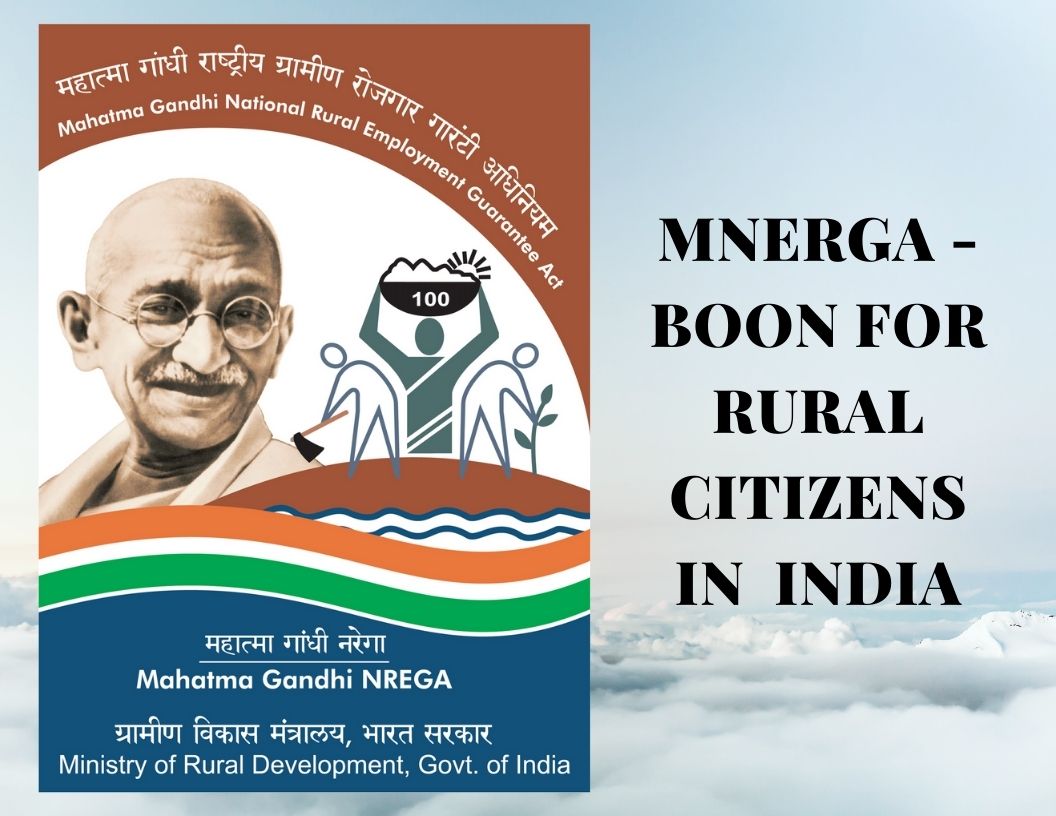
The Mahatma Gandhi National Rural Employment Guarantee Act (MGNREGA) was adopted in 2005 ,and it was first made operational in February 2006 in 200 of India’s poorest districts. Within two and a half years, it was extended to the rest of the country in April 2008. This act was a ground breaker; Although there were similar job creation programs in the past, this was the first time that the right to work was legally recognized. India`s growth in recent years has been driven by a rights-based approach and legal guarantees of rights; moreover, the Right to Education Act was passed in 2009, giving children between the ages of 6 and 14 the right to free and compulsory education. At the present, there is a talk of implementing the right to food as a right to life (Article 21 of the Constitution to prevent starvation and starvation in the country).
In India, more than 70% of the population lives in villages, and the rural economy is heavily dependent on agriculture. As a result, there is a major problem of seasonal employment, and a large number of rural population migrate in search of work in other areas during the slack season.
MGNREGA plays an important role in this regard by providing a legal guarantee of 100 days of employment in every financial year, which prepares adult members of all rural households to do unskilled manual work related to public work at minimum wages. As per the provisions of the Act, work is required to be provided to a person who registers for it within fifteen days from the date of demand, failing which they are eligible to receive unemployment allowance from the State Government. Therefore, the Act acts as a social safety net, provides employment to the poorest people and aims at inclusive growth and strengthening of the rural economy.
Inclusive growth :-
MGNREGA has been successful in increasing employment as compared to any previous government`s schemes. However, the success of MGNREGA was measured by me on various other parameters_ apart from generating employment, it also aims to achieve other socio-economic goals. For one, being intrinsically self targeting, it promotes social inclusion and economic empowerment of marginalized groups. According to the National Report 2010-2011 by the Ministry of Rural Development, which oversees the implementation of the scheme, Scheduled Castes comprise 22.56% man-days and Scheduled Tribes 17.27% man-days. Considering the rural system where the caste system has dominated the social system and deprives the backward communities of their rights, it is important and can play a role in improving the situation and their participation in local self-government can be an entry point.
Apart from this, MGNREGA has also sought to include women to a large extent. It not only provides them an opportunity to engage them in gainful employment but also promotes gender equality by setting equal pay rates for men and women. While the Act is committed to ensure at least 33% of workers are women, these requirements have been exceeded in most states. National Report 2010-2011 51.11% of person-days are for women. Hence, it helps in promoting economic independence and empowerment of women in rural areas through their financial independence.
The implementation of MGNREGA can stimulate further development in rural India through the macroeconomic concepts of multiplier and accelerator. MGNREGA self targeting creates purchasing power among the economically weaker sections. Their demand for the goods has resulted in an increase in production, which generates additional income. This process (multiplier effect) depends on the marginal propensity to consume (MPC) of those affected. To see that profit takers are at the bottom of the pyramid, their MPC is higher, and therefore, the effect is strong.
Rural Infrastructure and Employment:-
Another main focus of the Act is to create durable assets in rural areas and thereby boost the rural economy and encourage sustainable development. Projects related to rural connectivity, irrigation, flood control and drought proofing, land development are taken up to increase agricultural productivity.
In addition, job creation in rural areas is meant to curb migration. There are reports that women’s participation is higher ,as they find that living in their village is a good source of additional income, while men move to other areas for work. It was also intended to prevent seasonal migration during the sluggish agricultural season with the hope that it would prevent the education of rural children from being disrupted. However, the guarantee of 100 days of work in a year is often left unfulfilled ,and hence, MGNREGA crisis has not been completely successful in curbing migration. On the other hand, in the World Development Report 2009, the World Bank criticized MGNREGA for its negative impact on economic growth by discouraging rural-urban migration. According to the report, development requires urbanization, and the government should not fight the trend of concentrated economic activity in certain areas. However, India’s vast population and the existing high population density in large cities makes it troublesome for physical and social infrastructure to accommodate the amount of migrants. As a result of this, laborers in villages may receive higher wages. They often have to endure the living and working conditions in cities. Considering this, although urban centers are important for development, large numbers of rural-urban migrations without adequate infrastructure prove to be a burden, and hence , rural sectors require the creation of jobs. In such a situation, building infrastructures like roads and electric poles can create jobs in rural areas and help to convert villages into towns. The state of Tamil Nadu, which has been efficient in implementing MGNREGA, is the most urbanized state in the country ,and it has succeeded in this objective by focusing on the development of small towns rather than big cities.
Effect on Salary:-
Market wages in rural areas are expected to increase in almost all states. However, critics have attributed the scheme to a reduction in the supply of agricultural labor resulting in unsustainable agriculture and rising food prices. Labor shortage is forcing farmers to incur additional costs to replace cheap migrant laborers with machines. Increased prices of agricultural commodities have a negative impact and affect those who live the most on margins as they are most vulnerable to increase in prices.
Corruption and Delay:-
A common complaint is the delay at every stage – a person who registers for employment must be provided a job within 15 days, failing which he should be able to claim unemployment allowance. Further, the Act provides that wages should be paid within 15 days of employment. However, there are frequent delays in payments and workers often wait for months to receive their wages. Delayed warrant leads to compensation under the Payment of Wages Act. However, the problem has not been resolved due to an ineffective grievance mechanism. Also, for 2008-2009, there was 48 days of employment per household as against the national average of 100 days guaranteed. No state has implemented the unemployment benefit mechanism effectively ,and no allowance is given to those who are not given their 100 days of work on time.
Another problem in execution is corruption and leakage of funds. Although the Act emphasizes on transparency, some areas still witness high levels of corruption. For instance, public works in Orissa still follow the PC system where contractors, engineers and other officials ask for a certain percentage of the outlay. Jean Arthage, a development economist and one of the architects of MGNREGA, explained in a talk at St. Xavier’s College on 17 December, 2010 that areas where PC systems are taking a cut from middlemen’s funds, Corruption is not considered, provided they cut their regular percentage—only an amount above that was considered corrupt practice. Nevertheless, since the implementation of MNREGA, corruption has started decreasing. Social audits are conducted to monitor the functioning of the scheme, many muster rolls are available online, and people are gradually becoming more aware ,and therefore, they are able to monitor the system and ensure payments. The Act mentions various types of transparency safeguards; efforts should be made to implement them and punish those who indulge in corruption
In an effort to reduce corruption, wages should be paid through bank accounts and post offices to ensure that the entire amount reaches the workers. However, the sudden change created problems of its own. The banking system is finding it difficult to handle the volume of transactions which causes delay in payment of wages. It is also creating hardship for the laborers who live in remote areas and have to travel long distances to reach the banks. Nevertheless, it is a step in a positive direction and will play an essential role in improving the penetration of the banking system in rural India.
Another step to reduce corruption under the contractor system that involved contractors squeezing a percentage of the total project cost was the requirement under the Act that 60% of the total outlay for a project should go to labourers. However, a downside of this constraint is that it often results in the creation of assets that do not last long, such as makeshift mud roads, and therefore, do not effectively aid rural development.
Implementation of problems:-
One of the majorproblems faced by citizens is the lack of cooperation between the state governments and the Centre. The enthusiasm among the states has been inconsistent, and the poorest states of Bihar, Orissa and Jharkhand have not implemented it effectively. State governments have employment guarantee schemes and need to be in sync with the central government. Absence of such cooperation adversely affects the functioning of the scheme. Another problem is lack of suitable staff; A people-centric program like MNREGA requires a dedicated HR staff. However, there is a lot of bureaucratic control. In addition, the shortage of technical staff such as engineers leads to the construction of inefficient projects.
The Mahatma Gandhi National Rural Employment Guarantee Act was the first attempt to organize development rights in a legal context. Although it is not the key to the rejuvenation of rural areas or the end of poverty in India, it is an opportunity for the rural poor who remain on the margins to stake a minimal claim in the development process. India has over 260 million people living below the poverty line; MGNREGA, though not flawless, could prove to be their chance to come out of poverty completely , and the rest of the country is enjoying the growth.
CONCLUSION
MNREGA had helped in improving the condition of the poor and provided opportunities for employment to rural people. Thus, It helped in strengthening the economy of the country.
| Author: JAGANNATH PRADHAN,BHUBANESWAR |


